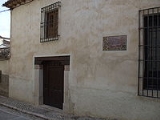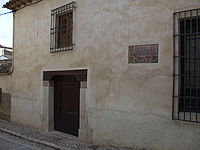
Chinchón
Encyclopedia
Chinchón is a Spanish town 50 km southeast of Madrid
. It is part of the Comarca de Las Vegas.
s and is used as a temporary bullring
. The church of Nuestra Señora de la Asunción was built in the 15th and 16th centuries. It contains a fine early work by Goya depicting the Assumption of the Virgin. There is also a medieval castle
, which, however, is somewhat damaged and also closed to the public.
Though small, Chinchón is known for its festivals, a big draw for people from nearby Madrid, and those visiting it. Two of the biggest are the Chinchón Festival de anis y vino, a celebration of locally distilled anisette and wine, which takes place and the end of March, and the October garlic festival. In October of each year the central plaza also offers a bullfighting exhibition with the profits going to charitable causes.
Population reached 4,943 inhabitants in 2006.
 The special geographical status of the plain of Tajuña facilitated human settlement since ancient times. Remains have been found that belong to more distant Neolithic
The special geographical status of the plain of Tajuña facilitated human settlement since ancient times. Remains have been found that belong to more distant Neolithic
next to a village probably Iberian or Celtiberians.
Later may be reflected in the presence of Roman roads and irrigation system in the Tajuña Muslim influence, then Christians would consolidate this work . The Christians regained control over that area when Alfonso VI of Castilla took Toledo
in 1085. Until 1480, when it became a dominion granted to the Marquis de Moya

, the main square of Chinchón and most of the population were employed for the filming of a bullfight featuring Cantinflas
.
Madrid
Madrid is the capital and largest city of Spain. The population of the city is roughly 3.3 million and the entire population of the Madrid metropolitan area is calculated to be 6.271 million. It is the third largest city in the European Union, after London and Berlin, and its metropolitan...
. It is part of the Comarca de Las Vegas.
Overview
The Plaza Mayor is roughly circular, surrounded by 15th-17th century galleried houses and caféCafé
A café , also spelled cafe, in most countries refers to an establishment which focuses on serving coffee, like an American coffeehouse. In the United States, it may refer to an informal restaurant, offering a range of hot meals and made-to-order sandwiches...
s and is used as a temporary bullring
Bullring
A bullring is an arena where bullfighting is performed. Bullrings are often associated with Spain, but they can also be found in neighboring countries and the New World...
. The church of Nuestra Señora de la Asunción was built in the 15th and 16th centuries. It contains a fine early work by Goya depicting the Assumption of the Virgin. There is also a medieval castle
Castle
A castle is a type of fortified structure built in Europe and the Middle East during the Middle Ages by European nobility. Scholars debate the scope of the word castle, but usually consider it to be the private fortified residence of a lord or noble...
, which, however, is somewhat damaged and also closed to the public.
Though small, Chinchón is known for its festivals, a big draw for people from nearby Madrid, and those visiting it. Two of the biggest are the Chinchón Festival de anis y vino, a celebration of locally distilled anisette and wine, which takes place and the end of March, and the October garlic festival. In October of each year the central plaza also offers a bullfighting exhibition with the profits going to charitable causes.
Population reached 4,943 inhabitants in 2006.
History

Neolithic
The Neolithic Age, Era, or Period, or New Stone Age, was a period in the development of human technology, beginning about 9500 BC in some parts of the Middle East, and later in other parts of the world. It is traditionally considered as the last part of the Stone Age...
next to a village probably Iberian or Celtiberians.
Later may be reflected in the presence of Roman roads and irrigation system in the Tajuña Muslim influence, then Christians would consolidate this work . The Christians regained control over that area when Alfonso VI of Castilla took Toledo
Toledo, Spain
Toledo's Alcázar became renowned in the 19th and 20th centuries as a military academy. At the outbreak of the Spanish Civil War in 1936 its garrison was famously besieged by Republican forces.-Economy:...
in 1085. Until 1480, when it became a dominion granted to the Marquis de Moya

In film
In Around the World in Eighty DaysAround the World in Eighty Days (1956 film)
Around the World in 80 Days is a 1956 adventure film produced by the Michael Todd Company and released by United Artists. It was directed by Michael Anderson. It was produced by Michael Todd, with Kevin McClory and William Cameron Menzies as associate producers. The screenplay was written by James...
, the main square of Chinchón and most of the population were employed for the filming of a bullfight featuring Cantinflas
Cantinflas
Fortino Mario Alfonso Moreno Reyes , was a Mexican comic film actor, producer, and screenwriter known professionally as Cantinflas. He often portrayed impoverished campesinos or a peasant of pelado origin...
.
External links
- Chinchon visitor information English

